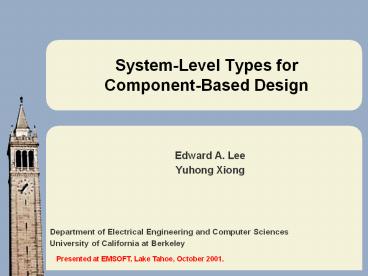System-Level Types for Component-Based Design - PowerPoint PPT Presentation
1 / 22
Title:
System-Level Types for Component-Based Design
Description:
Run-time reflection of component interfaces. Data types only specify static aspects of interface ... We can reflect component state in a run-time environment, ... – PowerPoint PPT presentation
Number of Views:19
Avg rating:3.0/5.0
Title: System-Level Types for Component-Based Design
1
System-Level Types forComponent-Based Design
- Edward A. Lee
- Yuhong Xiong
Presented at EMSOFT, Lake Tahoe, October 2001.
2
Outline
- Component-based design
- System-level types
- Interface Automata
- Interaction Types and Component Behavior
- Type Checking
- Type Order and Polymorphism
- Design Tradeoffs
- Conclusion
3
Component-Based Design
- Good for designing complex, concurrent,
heterogeneous systems - Two levels of interface
- data types and
- dynamic interaction
- Key aspects of dynamic interaction communication
execution
4
Type Systems
- Type systems are successful
- Safety through type checking
- Polymorphism supports reuse (flexible components)
- Interface documentation, clarification
- Run-time reflection of component interfaces
- Data types only specify static aspects of
interface - Proposal
- Capture the dynamic interaction of components in
types - Obtain benefits analogous to data typing.
- Call the result system-level types.
5
Interaction Semantics
- Flow of control issues (execution model -
Sifakis) - in Ptolemy II, these are defined by a Director
class - Communication between components (interaction
model) - in Ptolemy II, this is defined by a Receiver class
Actor interface for execution fire Receiver
interface for communication put, get, hasToken
6
Models of Computation
- Define the interaction semantics
- Implemented in Ptolemy II by a domain
- Receiver Director
- Examples
- Communicating Sequential Processes (CSP)
rendezvous-style communication - Process Networks (PN)asynchronous communication
- Synchronous Data Flow (SDF)stream-based
communication, statically scheduled - Discrete Event (DE)event-based communication
- Synchronous/Reactive (SR)synchronous, fixed
point semantics
7
Receiver Object Model
8
Formal Interaction SemanticsUse Interface
Automata
- Automata-based formalism
- Proposed by de Alfaro and Henzinger
- Optimistic
- Concise composition
- Compatibility checking
- Done by automata composition
- Captures the notion components can work
together - Alternating simulation (from Q to P)
- All input steps of P can be simulated by Q, and
- All output steps of Q can be simulated by P.
- Provides the ordering we need for subtyping
polymorphism - A key theorem about compatibility and alternating
simulation
9
Example SDF Consumer Actor
Inputs
Outputs
f fire
t Token
hTT Return True from hasToken
hTF Return False from hasToken
fR Return from fire
g get
hT hasToken
10
Type Definition - SDFDomain
11
Type Definition - DEDomain
12
Component BehaviorSDF Consumer Actor
13
Type CheckingSDF Consumer Actor in SDFDomain
SDFDomain
SDF Consumer Actor
Compose
14
Type CheckingSDF Consumer Actor in SDFDomain
15
Type CheckingSDFActor in DEDomain
Compose
DEDomain
SDF Consumer Actor
- Empty automata indicating incompatibility
16
Alternating SimulationSDF to DE
DEDomain
SDFDomain
?
17
System-Level Type OrderDefined by Alternating
Simulation
- Analogous to subtyping
- If an actor is compatible with a certain type, it
is also compatible with the subtypes
18
Component BehaviorDomainPolymorphicActor
19
DomainPolymorphicActor is Compatible with DEDomain
Poly Actor
Compose
DEDomain
20
So it is also Compatible with SDFDomain
Poly Actor
SDFDomain
Compose
21
Trade-offs in Type System Design
- Amount of property checked vs. cost of checking
- Static vs. run-time checking
- Example of more static checking deadlock
detection in Dining Philosopher model - Bottom line static checking of communication
protocols a good starting point
22
Conclusion and Future Work
- We capture dynamic property of component
interaction in a type system framework
system-level types - We describe interaction types and component
behavior using interface automata. - We do type checking through automata composition.
- Subtyping order is given by the alternating
simulation relation, supporting polymorphism. - We can reflect component state in a run-time
environment, providing system-level reflection.































